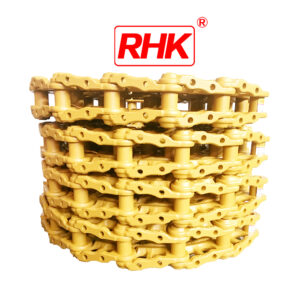An industry track link is a component of a track system that is used to support the weight of heavy machinery such as excavators, bulldozers, and other construction equipment. The track link is responsible for transferring the weight of the machine to the ground and providing traction for movement.
Here are some key features of industry track links:
Durability: Industry track links are typically made of high-strength materials such as steel or other alloys to ensure durability and resistance to wear and tear.
Precision: Industry track links are designed to precise specifications to ensure proper fit and alignment with other components such as pins, bushings, and shoes.
Low maintenance: Industry track links require minimal maintenance over their lifespan, but regular inspection and lubrication can help to extend their lifespan and ensure optimal performance.
Compatibility: Industry track links come in various sizes and designs to accommodate different types of machinery and track systems. It is important to select the correct track link for your specific application to ensure proper fit and performance.
Performance: Industry track links are designed to provide reliable and efficient performance in a range of operating conditions, such as uneven terrain, high loads, and harsh environments.
Testing: Industry track links are rigorously tested to ensure that they meet the required performance standards, such as load capacity, wear resistance, and fatigue strength.
Proper installation and maintenance are important to ensure the reliable and efficient operation of industry track links. China industry Track Link supplier This includes regular inspection and lubrication, as wellas proper alignment and tensioning of the track system. It is also important to follow any manufacturer recommendations or industry standards for installation and maintenance procedures.
In summary, industry track links are an essential component of track systems for heavy machinery, providing durability, precision, low maintenance, compatibility, and reliable performance. It is important to select the correct track link for your specific machinery and application, and to follow proper installation and maintenance procedures to ensure optimal performance and extend their lifespan.
Proper maintenance of industry track links is important to ensure their reliable and efficient operation over their lifespan.
Here are some common maintenance procedures for industry track links:
Regular inspection: Regular inspection of the track links can help to identify any signs of wear or damage, such as cracks, corrosion, or wear on the pins, bushings, and shoes. Inspections should be performed before and after each use, as well as at regular intervals depending on the operating conditions and usage.
Lubrication: Proper lubrication of the track links is important to reduce wear and tear, prevent corrosion, and ensure smooth operation. Lubrication should be performed regularly, using a lubricant that is recommended by the manufacturer or a qualified engineer.
Cleaning: Regular cleaning of the track links can help to prevent the buildup of debris or contaminants that can affect the performance of the track system. Cleaning should be performed using a mild detergent or cleaning solution, followed by thorough rinsing and drying.
Tensioning: Proper tensioning of the track system is important to ensure optimal performance and prevent excessive wear or damage to the components. Tensioning should be performed according to the manufacturer’s recommendations or industry standards, using a tension gauge or other appropriate tool.
Replacement of worn or damaged components: If any components of the track system are worn or damaged beyond repair, they should be replaced promptly to prevent further damage or failure of the system. Replacement components should be of the same quality and specificationas the original components, and installed according to the manufacturer’s recommendations or industry standards.
Adjustment of track alignment: Over time, the track system may become misaligned or uneven, which can affect the performance of the track links. Adjusting the track alignment can help to ensure even wear and prevent excessive stress on the track links.
Regular equipment maintenance: Regular maintenance of the machinery that uses the track system can also help to prevent damage or wear on the track links. This includes tasks such as regular oil and filter changes, cleaning of air filters, and inspection of hydraulic systems.
Overall, proper maintenance of industry track links is essential to ensure their reliable and efficient operation over their lifespan. Regular inspection, lubrication, cleaning, tensioning, and replacement of worn or damaged components can help to prevent issues and extend the lifespan of the track system. It is recommended to consult with the manufacturer or a qualified engineer for specific guidance on the maintenance of industry track links in your application.
